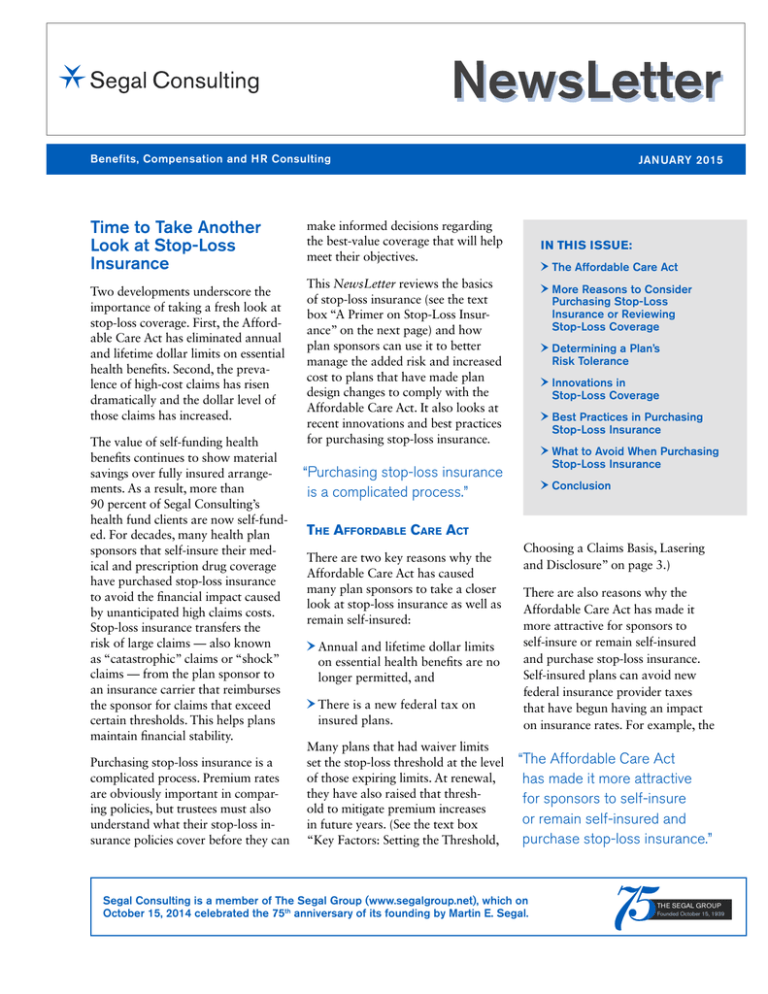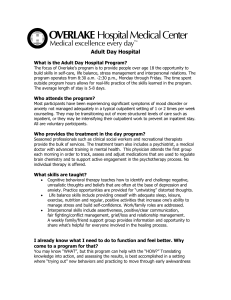
Benefits, Compensation and HR Consulting
Time to Take Another
Look at Stop-Loss
Insurance
Two developments underscore the
importance of taking a fresh look at
stop-loss coverage. First, the Affordable Care Act has eliminated annual
and lifetime dollar limits on essential
health benefits. Second, the prevalence of high-cost claims has risen
dramatically and the dollar level of
those claims has increased.
The value of self-funding health
benefits continues to show material
savings over fully insured arrangements. As a result, more than
90 percent of Segal Consulting’s
health fund clients are now self-funded. For decades, many health plan
sponsors that self-insure their medical and prescription drug coverage
have purchased stop-loss insurance
to avoid the financial impact caused
by unanticipated high claims costs.
Stop-loss insurance transfers the
risk of large claims — also known
as “catastrophic” claims or “shock”
claims — from the plan sponsor to
an insurance carrier that reimburses
the sponsor for claims that exceed
certain thresholds. This helps plans
maintain financial stability.
Purchasing stop-loss insurance is a
complicated process. Premium rates
are obviously important in comparing policies, but trustees must also
understand what their stop-loss insurance policies cover before they can
JANUARY 2015
make informed decisions regarding
the best-value coverage that will help
meet their objectives.
IN THIS ISSUE:
The Affordable Care Act
This NewsLetter reviews the basics
of stop-loss insurance (see the text
box “A Primer on Stop-Loss Insurance” on the next page) and how
plan sponsors can use it to better
manage the added risk and increased
cost to plans that have made plan
design changes to comply with the
Affordable Care Act. It also looks at
recent innovations and best practices
for purchasing stop-loss insurance.
More Reasons to Consider
Purchasing Stop-Loss
Insurance or Reviewing
Stop-Loss Coverage
Determining a Plan’s
Risk Tolerance
Innovations in
Stop-Loss Coverage
Best Practices in Purchasing
Stop-Loss Insurance
What to Avoid When Purchasing
Stop-Loss Insurance
“Purchasing stop-loss insurance
is a complicated process.”
Conclusion
The Affordable Care Act
There are two key reasons why the
Affordable Care Act has caused
many plan sponsors to take a closer
look at stop-loss insurance as well as
remain self-insured:
Annual and lifetime dollar limits
on essential health benefits are no
longer permitted, and
There is a new federal tax on
insured plans.
Many plans that had waiver limits
set the stop-loss threshold at the level
of those expiring limits. At renewal,
they have also raised that threshold to mitigate premium increases
in future years. (See the text box
“Key Factors: Setting the Threshold,
Choosing a Claims Basis, Lasering
and Disclosure” on page 3.)
There are also reasons why the
Affordable Care Act has made it
more attractive for sponsors to
self-insure or remain self-insured
and purchase stop-loss insurance.
Self-insured plans can avoid new
federal insurance provider taxes
that have begun having an impact
on insurance rates. For example, the
“The Affordable Care Act
has made it more attractive
for sponsors to self-insure
or remain self-insured and
purchase stop-loss insurance.”
Segal Consulting is a member of The Segal Group (www.segalgroup.net), which on
October 15, 2014 celebrated the 75th anniversary of its founding by Martin E. Segal.
THE SEGAL GROUP
Founded October 15, 1939
NewsLetter
“Insured plans must cover new benefits, including wellness
programs and fertility treatments, which can be very expensive.”
Annual Health Insurance Industry Fee,
which funds some of the provisions of
the Affordable Care Act, has increased
insurance rates by approximately
2.5 to 3.0 percent (in addition to existing state premium taxes that can also be
as high as 2 to 3 percent of premium).
Insured plans must cover new benefits, including wellness programs and
fertility treatments, which can be very
expensive. Plans that self-insure have
the flexibility to decide whether they
want to cover these new benefits.
More Reasons to Consider
Purchasing Stop-Loss Insurance
or Reviewing Stop-Loss Coverage
In addition, plan sponsors should
also consider purchasing stop-loss
insurance to mitigate risk caused by
A Primer on Stop-Loss Insurance
Stop-loss insurance is commonly offered in two forms:
Specific (individual) stop-loss insurance protects the plan sponsor against a
large claim on any individual and limits the plan sponsor’s liability to a set dollar
figure (the threshold or deductible) per person, per policy year. For example,
a plan sponsor may elect a threshold or deductible of $200,000. That means
the sponsor is responsible for each individual’s claims up to $200,000 and the
insurer will reimburse the sponsor for claims that exceed that amount. Although
specific stop-loss insurance protects the sponsor against individual “shock”
claims, it does not protect against other expenses, such as a large number
of high claims from more than one participant that do not exceed the
individual threshold.
Aggregate stop-loss insurance protects the plan sponsor against total
paid claims liability. The sponsor’s maximum liability is expressed in terms of
a percentage of its total expected claims, typically 120 to 125 percent. The
level chosen is known as the “attachment point.” For example, a plan sponsor
with a 120 percent attachment point and expected total annual claims of
$10 million would be reimbursed for claims that exceed $12 million, usually
up to a maximum of $1 million annually.
The stop-loss insurer determines the plan sponsor’s total expected claims amount
based on the sponsor’s monthly paid claims history and enrollment information,
which the sponsor must provide the insurer during the bid process. In most
instances, plan sponsors can buy specific stop-loss insurance without aggregate
stop-loss insurance, but they cannot typically buy aggregate stop-loss insurance
without specific stop-loss insurance. Moreover, claims that are reimbursed under
specific stop-loss coverage often do not apply to the sponsor’s aggregate stoploss coverage. As a result, the sponsor’s likelihood of exceeding its maximum
liability and being reimbursed by its aggregate stop-loss insurer is extremely
low. This leads most sponsors to purchase specific stop-loss insurance and not
aggregate stop-loss coverage, even though aggregate stop-loss insurance is fairly
inexpensive. In general, aggregate stop-loss insurance is usually purchased by
small plans (with 300 to 500 participants) that are self-insuring for the first time.
Purchasing aggregate stop-loss insurance for the first year or two can help protect
against financial shocks in the case that reserves are still being developed or until
the sponsor develops comfort with the plan’s underlying self-insurance liabilities.
2
the following unpredictable and potentially high-cost items.
The expansion of high-cost specialty
medications for diseases such as
hepatitis C, cancer, hemophilia and
rheumatoid arthritis will raise risk
significantly. Many of these drugs
cost tens of thousands of dollars per
month. Specialty medications are
replacing less-expensive regular drugs.
Segal recommends purchasing stoploss insurance that covers prescription
drugs as well as hospital and medical.
(See more on this on page 6.)
Expensive life-saving treatments,
such as organ transplants, dialysis
and neonatal intensive care, are also
contributing to the unpredictability of
plan costs and could result in deficit
spending for some plan sponsors.
Determining a Plan’s
Risk Tolerance
As applied to stop-loss insurance, risk
tolerance can best be described as the
total annual claims amount a plan is
able to pay for during the course of a
policy year. Another measure of risk
tolerance is the willingness, or lack of
will, to spend down current fund assets and reserves. To determine a plan’s
ability to tolerate risk, plan sponsors
must consider the following factors:
Group Plan Size and Reserve Level
The likelihood of claims higher
than $1 million continues to be
small from an actuarial basis, but
the practical impact of such claims
can vary depending on the size and
reserve level of a plan. For example,
a plan with $2 million in annual
claims expenses with $2 million in
reserves versus a plan with $10 million in annual claims expenses with
$10 million in reserves — both have
12 months of reserves — but the
impact of a $1 million claim would
lower the $2 million plan reserve to
six months (or a 50 percent drop)
Key Factors: Setting the Threshold, Choosing a Claims Basis,
Lasering and Disclosure
Setting the Threshold
A plan sponsor’s threshold should reflect its risk tolerance — the degree of variability in claims the sponsor is willing to withstand. Although the most common
threshold (the per-person, per-policy-year maximum that triggers stop-loss coverage) is in the $200,000 to $250,000 range, there are several factors for sponsors
to consider. Most important is the size of the insured group. The smaller the group,
the lower the threshold should be because small groups will usually have a harder
time absorbing large losses.
Choosing a Claims Basis
Before sponsors can choose or renew a stop-loss policy, it is a wise practice to
obtain bids from a number of insurers. After this, it is important to compare the contract terms, especially the claims basis — the number of incurred months covered
followed by the number of paid months covered.
For example, a common claims basis is expressed as 12/15. Assuming a January
1, 2014 effective date, only claims incurred during calendar year 2014 (12 months)
and paid during calendar year 2014 and the first three months of 2015 (15 months)
would be covered. Thus, three months of run-out claims are covered. This is important, since months can pass between when a claim is initially incurred and when
it is ultimately paid.
Although every plan is different, most should choose a policy with a significant
run-in or run-out period, such as a 12/18, 12/24 or 24/12 contract. Because large
and/or complicated claims can take a long time to be adjudicated, a claim that is
incurred near the end of contract might not be paid for several months after the
contract has ended. Moreover, this can be an important and relatively inexpensive
way to manage risk: a 12/18 claims basis usually costs less than 5 percent more
than a 12/15 claims basis and a 12/24 claims basis usually adds only 2 percent to
the 12/18 premium.
Lasering
Lasering transfers the claims risk of certain individuals with known catastrophic
ailments to the plan by increasing the stop-loss threshold for those individuals
or increasing the premiums beyond “normal” leveraged trend, which is currently
15 to 22 percent. Theoretically, specific stop-loss premiums, as well as most forms
of insurance, are priced based on unknown risk. The insurer chooses to laser an
individual to either mitigate those known claims cost risks or the insurer “prices in”
a portion of the expected claims cost to the policy year’s premiums.
Although it is possible to negotiate a no-laser contract, the economics must be
reviewed with care. A no-laser contract will be more expensive and the sponsor’s
total financial burden could exceed paying for a lasered contract and covering the
expenses of any participants who have been lasered.
Disclosure
Before an agreement can be reached, all stop-loss insurance insurers will require
plans to complete a disclosure statement that includes the diagnosis, prognosis,
case management notes and amount spent for any participant who has a claim that
exceeds 50 percent of the proposed threshold in the current policy year. The plan
also must disclose information on any participant who is currently hospitalized
or has certain conditions that have the potential to reach the threshold. Plan
sponsors must take the appropriate steps to comply with all HIPAA privacy
and security mandates.
3
and the $10 million plan reserve
to 10.8 months (approximately a
10 percent drop). All things being
equal, a larger plan is better able to
absorb the impact of large claims.
Claims History Reviewing the
plan’s claims history for the past
few years can provide insight into
claims patterns and some sense of
what to expect going forward.
Population How stable is the
participant population? Does the
group go through sizeable swings
in turnover? Have the plan’s
demographics gotten older? Other
factors, such as a large group of
COBRA participants or pre-Medicare-eligible retirees, will affect
a plan’s risk tolerance because
the utilization and medical cost
variability of these groups is higher
than average. Any major change
to a fund’s risk exposure should
be evaluated to determine if the
change is within the trustees’ tolerance level.
Determining and understanding the
plan’s risk tolerance is an important
exercise for plan sponsors.
Segal uses a proprietary Multiemployer Health Fund Stop-Loss
Database to help clients benchmark
what other funds have purchased.
Using this database of more than 200
health funds, Segal can tell plan sponsors the most common stop-loss
deductibles being purchased for
similar-sized health funds. The database can provide insights into other
typical policy features, such as the
expected range of premiums being
paid by coverage level and whether
prescription drugs are excluded or
included in the stop-loss policy. This
data can help plan sponsors determine the right coverage levels to
obtain if stop-loss insurance makes
sense for a particular plan.
NewsLetter
Innovations in
Stop-Loss Coverage
consistently good experience and to
promote client loyalty.
There have been a number of significant recent changes and advances in
stop-loss policies. It is important for
plan sponsors that are considering the
purchase of stop-loss coverage to be
aware of the following innovations:
Dividend-eligible policies refund
a portion of a plan’s premium as
a dividend if its annual claims are
below a certain level. See the figure
below for an example of how such
an arrangement is calculated. Under
most dividend-eligible contracts,
a plan may need to remain with
the insurer for two or three years
(depending on the plan’s size)
before becoming eligible for a
dividend. Insurers use dividend-eligible contracts to reward plans with
High thresholds set the plan
deductible level at relatively high
levels such as $1 million and above,
protecting the plan against rare but
potentially catastrophic claims for
a relatively small premium. Most
commonly considered by large
plans with healthy reserves, a high
threshold, such as $500,000, can
also be a good option for self-insured plans that are purchasing
stop-loss insurance for the first
time because of the Affordable
Care Act.
Rate cap guarantees limit the
amount that an insurer can raise
the premium in a subsequent year
or years. A rate cap offers protection from a high-claims year that
Example of a Stop-Loss Dividend Calculation
Annual Premium
Lives
Effective Date
Plan Maximum
Policy Year
First year: $500,000
Second year: $560,000
1,000
7/1/2014
Unlimited
Paid Premium
Reimbursed Claims
7/1/14 to 6/30/15
$500,000
$200,000
7/1/15 to 6/30/16
+ $560,000
+ $300,000
Total
$1,060,000
$500,000
Total Paid Premium
$1,060,000
Carrier Minimum Loss Ratio*
65%
Total Net Premium
$689,000
Total Reimbursed Claims
$500,000
Excess Surplus
$189,000
Policyholder Share
25%
Dividend$47,250
* The ratio of total claims incurred over the total premium income due for each policy for a specific policy period
could cause the sponsor’s rates to
soar upon renewal. Larger plans
will have more leverage to secure
second year premium rate increase
caps. Segal’s Multiemployer Health
Fund Stop-Loss Database includes
information on rate caps.
No-new-laser contracts mandate
that the stop-loss insurer cannot
laser any new individuals when
the contract is renewed. (For a
definition of lasering, see the text
box “Key Factors: Setting the
Threshold, Choosing a Claims
Basis, Lasering and Disclosure”
on page 3.) This usually adds
5 to 7 percent to the premium
and should be used in conjunction
with a rate cap to maintain the
transfer of risk to the stop-loss
carrier at renewal.
A defined rate renewal methodology
bases the renewal rate on the plan’s
claim reimbursements in relation to
the premiums paid. For example,
the contract might stipulate that
a claim reimbursement rate of
70 percent (where 70 percent of the
net premium was used to reimburse
claims) would produce a renewal
rate with a 15 percent increase.
This takes the subjectivity out of
the renewal process and allows the
plan sponsor to clearly understand
upfront how the renewal will
be determined.
Prescription drug-only stop-loss
insurance could be appropriate for
some plans. Plans that insure their
medical coverage and self-fund their
drug coverage and plans that carve
prescription drugs out of their medical coverage should be aware that
their stop-loss policy may not cover
prescription drugs. Some insurers
and pharmacy benefit managers
(PBMs) are now offering aggregate
stop-loss insurance for prescription
drugs only.
4
NewsLetter
Best Practices in Purchasing
Stop-Loss Insurance
Sponsors who purchase stop-loss
insurance should consider these
best practices:
Select the appropriate specific
deductible levels. Some large plans
can afford to raise the front-end
specific deductible to lower future
premiums. Other funds that have
taken on too high a deductible are
vulnerable to one or two catastrophic claim events. Segal can
help trustees select a specific deductible for a plan’s risk-tolerance
and cash-flow needs.
Negotiate a renewal provision. Ask
the stop-loss carrier to provide a renewal request that outlines the new
policy and includes a rate quote
90 days before the current policy
expires. This gives the sponsor time
to evaluate the renewal and, if necessary, solicit bids to secure better
pricing and coverage provisions.
Plan ahead. Although multi-year
policies are rare, sponsors can
negotiate specific stop-loss rates
for multiple years under certain
conditions and using the strategies
discussed above (e.g., rate caps and
no-new-laser provisions). A renewal
rate methodology that is based on
claim reimbursements in relation to
net premiums paid will help generate consistency.
Consider including prescription
drug coverage under the stop-loss
policy. When purchasing specific
stop-loss insurance, Segal suggests
covering prescription drugs in
addition to hospital and medical
“Segal can help trustees select
a specific deductible for a
plan’s risk-tolerance and cashflow needs.”
coverage. The emergence of expensive specialty drugs raises the risk
that plans will experience extremely
high drug costs. Prescription drug
coverage, which generally adds 5 to
8 percent to the cost of a stop-loss
policy, offers protection against
large drug claims.
Remove retirees and their spouses
who are covered by Medicare from
the stop-loss coverage. Medicare
will cover the majority of Medicare retiree and spouse costs. Some
insurers may include Medicare
retirees and Medicare spouses in
setting their rates, which could
distort the true underlying cost of
the coverage.
Take a close look at aggregating
specific stop-loss insurance. Not to
be confused with aggregate stoploss insurance, aggregating specific
stop-loss insurance is a variation
of specific stop-loss insurance. It
is unique in that a separate aggregate deductible must be met by all
claims that exceed the individual
stop-loss deductible before the
sponsor is reimbursed for large
claims. While aggregating specific
stop-loss insurance reduces specific
stop-loss premiums, it also reduces the reimbursement amount for
stop-loss claims. For example, a
plan that pays a $2 million premium for a stop-loss policy might
receive a $750,000 reimbursement
for a claim. While the same plan
might pay $1.9 million for an
aggregating specific stop-loss
policy, it would receive only
$650,000 for the same claim.
Although many plan sponsors have
found aggregating specific stop-loss
policy prices favorable and a good
value, it often makes financial sense
to raise the deductible slightly on
a specific stop-loss policy in lieu
of purchasing aggregating specific
stop-loss insurance.
“Timing is crucial, particularly
with lasering issues, where
carriers may ask for more claims
information during the final
stages of evaluation.”
Provide disclosure information to
the insurers who are bidding on the
contract during the initial bid submission. This will avoid last-minute
lasering, which could shift significant risk back to the plan sponsor.
Following this practice may require
that the bid process be conducted
within 60 to 90 days of the proposed effective date.
Establish a timeline for the bidding
process. Putting the carriers on a
timeline and having them agree up
front can avoid problems. Timing
is crucial, particularly with lasering
issues, where carriers may ask for
more claims information during the
final stages of evaluation.
What to Avoid
When Purchasing
Stop-Loss Insurance
A proven bid process is an important
part of securing competitive rates and
meaningful coverage. The Segal bid
process features a detailed questionnaire that compares insurers on an
apples-to-apples basis. The process
requires plan sponsors to provide an
extensive claims history in order to
get the most aggressive pricing. Asking
carriers to make inferences about prior
plan history tends to produce less
attractive rates and terms. The bid process will help plan sponsors who are
purchasing stop-loss insurance avoid
the following problems:
Gaps in coverage. If the coverage
between one stop-loss policy and
the next is not seamless, the plan
cannot be certain all claims will
covered. It is also important that
5
NewsLetter
“A
well-run bid process will
eliminate unacceptable clauses
and provisions such as certain
audit and disclosure rules
suggested by some insurers.”
the plan’s existing exclusions and
limitations match the terms offered
in the specific stop-loss contract to
avoid creating a gap in insurance
coverage. A Mirroring Endorsement
in the stop-loss contract will ensure
that the carrier will cover everything that the plan covers.
Carriers with poor financial ratings. Plan sponsors should carefully
consider the financial rating of a
carrier. Many plans will not purchase coverage from a carrier with
a rating below B+ from the rating
agencies (e.g., the A.M. Best
Company, Standard & Poor’s
and Moody’s).
Bids with different assumptions
and underlying conditions. A
well-run bid process will eliminate
unacceptable clauses and provisions
such as certain audit and disclosure
rules suggested by some insurers.
Conclusion
The main objective of stop-loss
insurance is to transfer some of the
catastrophic risk to an insurer. This
allows plan sponsors to reap the
savings of self-funding while avoiding
the financial shock that can result
from large health plan claims. In
doing so, stop-loss insurance makes
it easier for plan sponsors to budget,
protect reserves and maintain
financial stability.
Understanding and purchasing stoploss insurance is complex. There are
many factors for plan sponsors to
consider, including the plan’s financial
situation and risk tolerance.
Plan sponsors that understand the
points covered in this NewsLetter
will be well equipped to review their
stop-loss coverage requirements,
make the important decisions about
what kind of contract to negotiate
“Stop-loss insurance makes
it easier for plan sponsors to
budget, protect reserves and
maintain financial stability.”
and, ultimately, procure the right
coverage at a competitive price.
For more information about stoploss insurance for multiemployer
health plans, contact your Segal
Consulting benefits consultant or
Michael S. Tesoriero at 212.251.5280
or mtesoriero@segalco.com.
To receive NewsLetters and
other Segal Consulting publications of interest to
sponsors of multiemployer
plans as soon as they are
available online, register your
e-mail address via Segal’s
website: www.segalco.com
For a list of Segal’s 22 offices,
visit www.segalco.com/aboutus/contact-us-locations/
Segal Consulting is a
member of The Segal Group
(www.segalgroup.net).
www.segalco.com
Copyright © 2015 by The Segal Group, Inc. All rights reserved.




